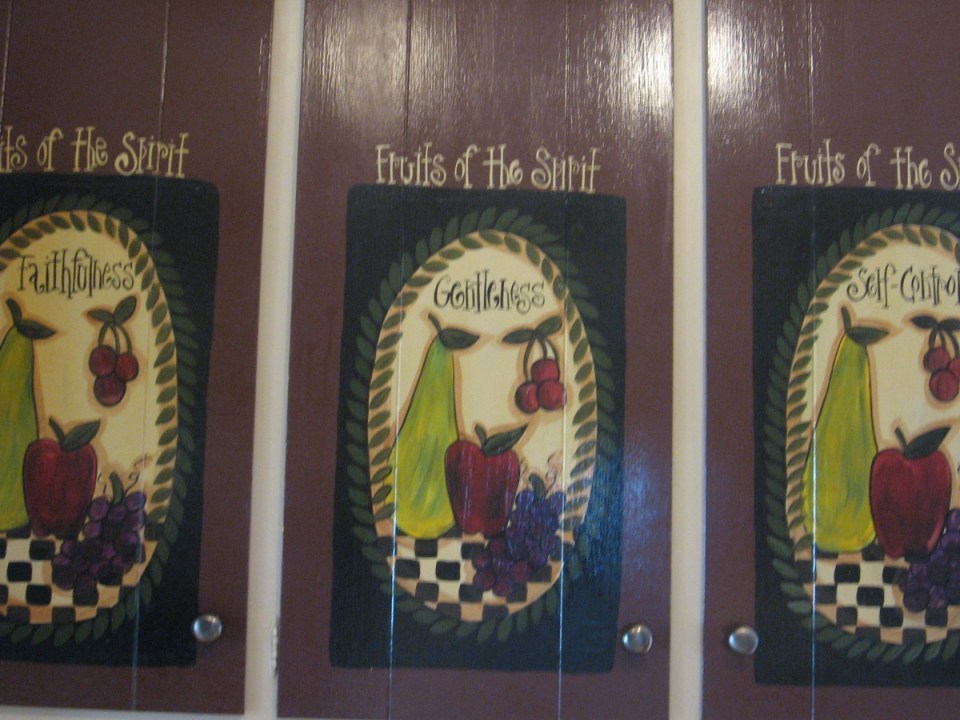Here’s what happened.
A recent conversation with my spouse —
“Have you ever noticed that when new people come to our house they think we’re, I don’t know, religious?” I asked.
My husband sat across from me at our high-top, wood table. Brow raised, he said nothing.
I continued, “I think it has something to do with our cabinets.”
When we purchased our house almost ten years ago, I loved the kitchen. Floor to ceiling windows line the east wall, flanked by two equally large windows to the north and south. The light in the morning is spectacular. There’s exposed brick and an open, but cozy feel. It’s not a large kitchen by today’s standards, but it’s a far cry from the galley kitchen in our first home. And, it’s where everyone gathers when we have a small get-together. They rarely migrate to the great room a mere few feet from the kitchen.
Not too long ago, a friend seated at the very same table remarked about the cabinets. She didn’t remember that we inherited them. We’ve done nothing to our kitchen except replace a faucet that blew up (that’s a funny story for another time.) So, she believed that we decided to paint our cabinets using a religious theme. And she didn’t think that this was strange even though she knows us.
Curious about our cabinets, yet? Here they are.

My husband and I had no idea that this came from the Bible until we looked more closely at the design. The painter referenced the chapter and verse. We also weren’t offended by it because, I mean really, who would be? Whether these are “fruits of the spirit” or simply good values or character strengths, we appreciated the message.
What things have you inherited from the previous owner of your home that you kept? Why did you keep it?
The items we choose to display in and around our home give clues about who we are. Sometimes what we choose to display really represents us, but other times, like in the case of our cabinets, they don’t.
Lesson: Be careful how you read other people’s environments.
What do the researchers say?
Recently, I read Vanessa Van Edward’s book, Captivate. It’s an interesting and informative read (in fact, I’m listening to it, again!) She wrote a great post about the topic of snooping and referenced Dr. Sam Gosling, the author of Snoop: What your stuff says about you.
Our stuff tells people about our identity, values, and personality. Look around your space now. I bet you’ll be able to classify everything into one of these three categories:
- Identity claims (stuff that gives clues about who we are, our personality, or values — examples: Crosses on walls, books, posters, etc.)
- Feeling regulators (things that give us a warm-fuzzy feeling; make us feel secure — examples: pictures of family and friends)
- Behavioral residue (the stuff we’ve left in our wake — examples: wrappers, pile of unopened mail, etc.)
When Vanessa suggested doing this, I scanned our kitchen and realized how easy it is to gather information about other people, even if that information isn’t necessarily correct.
Lesson: You still need to listen to and engage with the person.
Still not convinced?
The next time you’re invited to a party, look around for the items listed above. What fits into those categories? Then, start chatting with the host about a specific item. For example, if you see books about gardening, you might assume that these are identity claims. But, do they belong to the host or someone else in the house? Is the person a wanna-be master gardener or the real deal?
In our house, you’ll find several books about gardening including: garden design, organic gardening, homesteading, and container gardening. Do these identity claims belong to me, or to my spouse? If you asked me, you’d quickly learn that I love the idea of gardening more than the execution, and that I call myself “the lazy gardener” (I’m even lazily writing a book about my experiences.)
There are clues about us, and everyone we meet, everywhere. If you’re an introvert like me, who has challenges striking up a conversation at parties or networking events, snooping can prove helpful.
Want a little more practice?
What does this picture tell you about me?

Tweet Kori D. Miller and let me know! What am I sharing with the world (or, at least, the people who come into our kitchen)?
If you found this information useful, please consider sharing it with your friends.
Originally published at korimillerwrites.com

